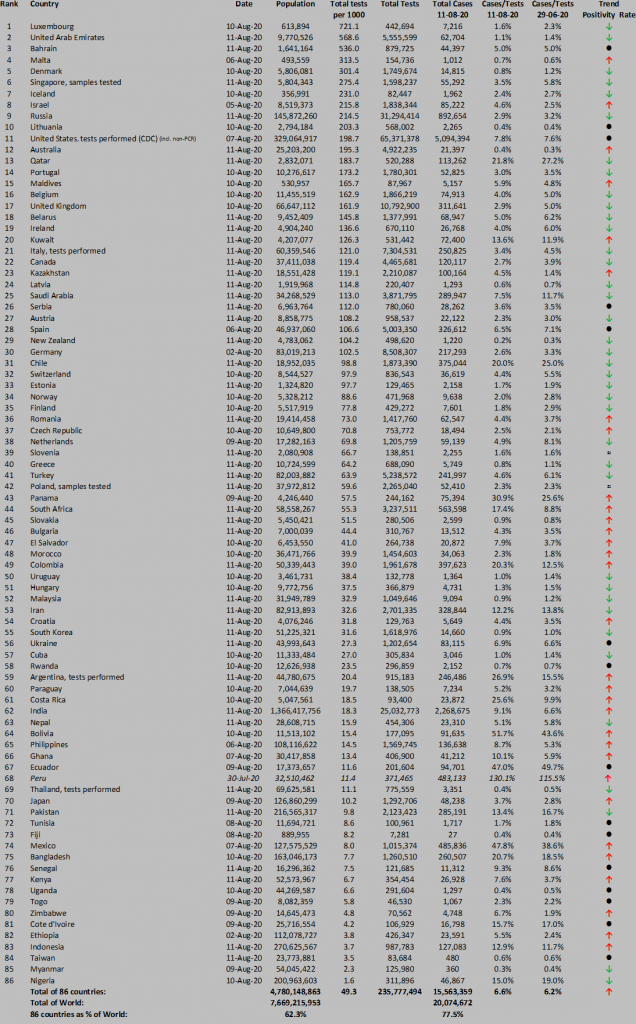What do Luxembourg, UAE and Bahrain have in common?
Well, for starters, they are not big countries. The United Arab Emirates are roughly the size of Austria (83,600 km2), with little less than 10 million inhabitants. Luxembourg and Bahrain are outright small. Luxembourg has the fewest inhabitants of the two (614,000), Bahrain the smallest territory (780 km2).
But it is not size that unites them. Nor is it their fiscal regime, for that matter. What binds these three is that they are the only countries that so far have carried out more than 500 corona tests per 1000 inhabitants.
Scrolling down the list, we notice more startling things. The prominent position of islands Malta, Iceland and Singapore jumps to the eye. The United States rank higher than one might expect. Their numbers are inflated, however. In their reporting, they do not differentiate between PCR (virus) tests and serology (antibodies) tests.
Furthermore, the position of The Netherlands is remarkable. Worldwide middle of the pack at rank 38, they are preceded by all Western European countries.
And how about the absentees? France and Sweden notably, who do no longer issue reports on their test numbers.
Of course the number of tests is only half of the story. The other half is the size of the outbreak in a given country, the number of cases. This is why we have included in the table the overall positivity rate, and the comparison with the same ratio six weeks earlier. The positivity rate is the ratio of the number of cases to the number of tests. A lower value is indicative of a better control of the pandemic.
Values higher than 30% are worrying. Latin American countries Panama, Bolivia, Ecuador, Mexico are not testing enough. The pandemic risks to propagate fast. Having said this: a value above 100%, as in the case of Peru, does not make sense. The anomaly originates in the country’s way of reporting. The very same patient tested positive via 2 different tests counts for 2 cases.
When we arrive at the bottom of the list, we are in for a shock. Taiwan, the pandemic model student, at rank 84? Only 2 countries have tested a lower fraction of their population? Once more, this is an illustration of how we cannot decouple the number of tests from the number of infections found. Until now, Taiwan has successfully suppressed the viral outbreak.
Unfortunately, the same does not hold for Nigeria. Africa’s most populous country closes this ranking. Overall, 1 in 7 tests comes back positive. The virus is still bound to spread.
Look in detail at the Table below, or:
Download the data in *.xlsx-format

Sources
data on COVID-19 cases and deaths per country: European Centre for Disease Prevention and Control
data on COVID-19 tests per country: Our World in Data
Note
Our World in Data collects testing numbers of 86 countries. We have made a snapshot of these data on August 11, or the latest date prior to that for which a country had provided its numbers. Why August 11? On this day, the world passed the threshold of 20,000,000 infections.
The numbers pertain to PCR (virus) tests, not serology (antibodies) tests, unless indicated otherwise (notably: US). Some countries report both the number of people tested and the number of tests carried out. In those cases, we have chosen the latter, as the more relevant parameter.
The table includes the positivity rate, the percentage of tests returned positive. For each country, the value of this ratio on August 11 has been compared with the one on June 29 – the date on which the global of number of cases exceeded 10,000,000. in our opinion, along with the positivity rate itself, it is the change of this parameter that reflects a country’s testing performance. The last column shows whether this value went up (>10% higher), down (>10% lower), or remained constant (less than 10% change).
(rvdk)



Pingback: Testing in the Hexagon - The Corona Diaries
Pingback: A lower mortality rate: fact or artifact? - The Corona Diaries
Pingback: Across the border An absurd thought experiment
Pingback: Antibodies against SARS-CoV-2 in Iceland: new insights - The Corona Diaries